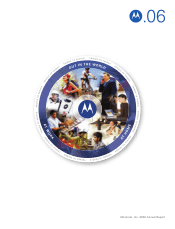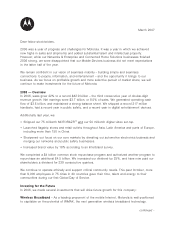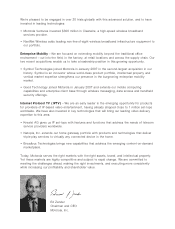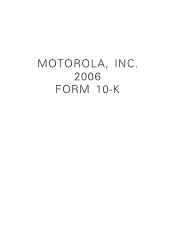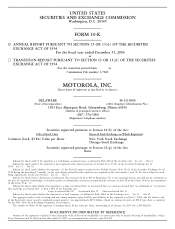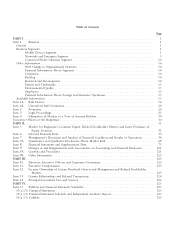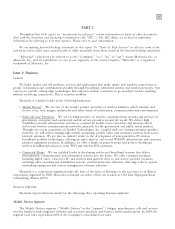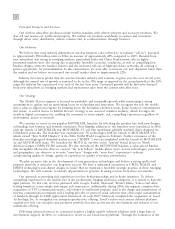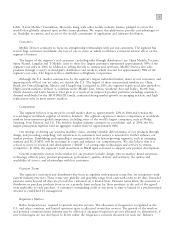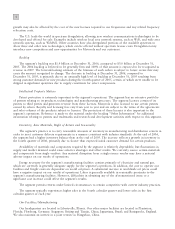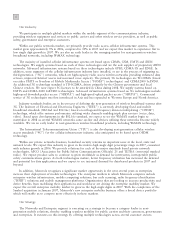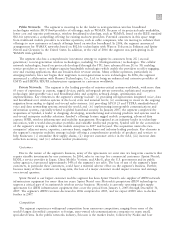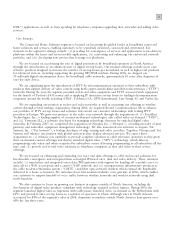Motorola 2006 Annual Report Download - page 10
Download and view the complete annual report
Please find page 10 of the 2006 Motorola annual report below. You can navigate through the pages in the report by either clicking on the pages listed below, or by using the keyword search tool below to find specific information within the annual report.
2
Principal Products and Services
Our wireless subscriber products include wireless handsets with related software and accessory products. We
also sell and license our intellectual property. We market our products worldwide to carriers and consumers
through direct sales, distributors, dealers, retailers and, in certain markets, through licensees.
Our Industry
We believe that total industry shipments of wireless handsets (also referred to as industry ""sell-in'') increased
to approximately 980 million units in 2006, an increase of approximately 20% compared to 2005. Demand from
new subscribers was strong in emerging markets, particularly India and China. Replacement sales in highly-
penetrated markets were also strong due to generally favorable economic conditions, as well as compelling new
handset designs, attractive handset features and the increased roll-out of high-speed data networks, all creating a
greater opportunity for personalization. In this environment, we were able to increase our unit shipments faster than
the market and we believe we increased our overall market share to approximately 22%.
Industry forecasters predict that the wireless handset industry will continue to grow over the next several years,
although the annual rate of growth is expected to be in the 10% range as opposed to the annual growth in the 20%
range the industry has experienced over each of the last four years. Continued growth will be driven by demand
from new subscribers in emerging markets and replacement sales from the current subscriber base.
Our Strategy
The Mobile Devices segment is focused on profitable and sustainable growth while maintaining a strong
commitment to quality and an unrelenting focus on technology and innovation. We recognize the role the mobile
device plays in digital convergence by breaking down the boundaries between work, home, business, entertainment
and leisure. A central theme to Mobile Devices' strategy is our vision of seamless mobility, which leverages the
trends in digital convergence by enabling the consumer to enjoy simple, rich, compelling experiences regardless of
environment, device or network.
We continue to invest in our popular MOTORAZR franchise by refreshing the product line with new designs,
cobranding, new features and network extensions. New flagship additions to the franchise were introduced in 2006
with the launch of MOTOKRZR and MOTORIZR Z3, our first quad-band, globally available slider designed for
GSM-based networks. The franchise was expanded into 3G technologies with the launch of MOTORAZR V3x
which earned ""Best 3GSM Handset'' at the 2006 3GSM World Congress in February. Further extensions of the
franchise into high-speed downlink packet access (""HSDPA'') were accomplished with the launch of MOTORAZR
xx and MOTORAZR maxx. We launched the MOTO Q, our first iconic ""qwerty''-based device on North
America's largest CDMA EV-DO network. We also introduced the MOTOFONE handset, a value-priced handset
that strengthens Motorola's drive to connect ""the next billion'' mobile phone users. Across technologies, price tiers
and geographies, our objective is to unite ""must have'' design with ""must have'' experiencesÌwithout
compromising quality of design, quality of experience or quality of product performance.
We play an active role in the development of next-generation technologies and believe a strong intellectual
property portfolio is critical to our long-term success. We have a substantial investment in UMTS, WiMAX and
HSDPA technologies and chipset designs to ensure that we maintain a favorable strategic position in these emerging
technologies. We will continue to identify opportunities to generate licensing revenue from these investments.
Our approach to providing rich experiences involves both partnerships and in-house initiatives. To deliver
compelling experiences to the mobile user in the productivity, imaging and music categories, it is critical to have the
right partners. To that end, we have partnered with Google, Kodak, Microsoft, Warner Music, Yahoo! and other
leading brands to create simple and unique rich experiences. Additionally, during 2006, the segment completed the
acquisition of TTP Communications plc, a developer of intellectual property used in the design and manufacture of
wireless communication terminals and a leading provider of protocol stack software that offers rapid customization
of handsets through its AJAR applications framework. In early 2007, Motorola completed the acquisition of Good
Technology, Inc. to strengthen our enterprise-productivity offering. Good's end-to-end content delivery platform
expands not only our enterprise and prosumer portfolio but also accelerates the development and richness of our
multimedia offering
Delivering advanced services to consumers requires a highly-capable software platform with a large base of
development support. In 2006, we continued to invest in our Linux-based platform. Through the formation of the

